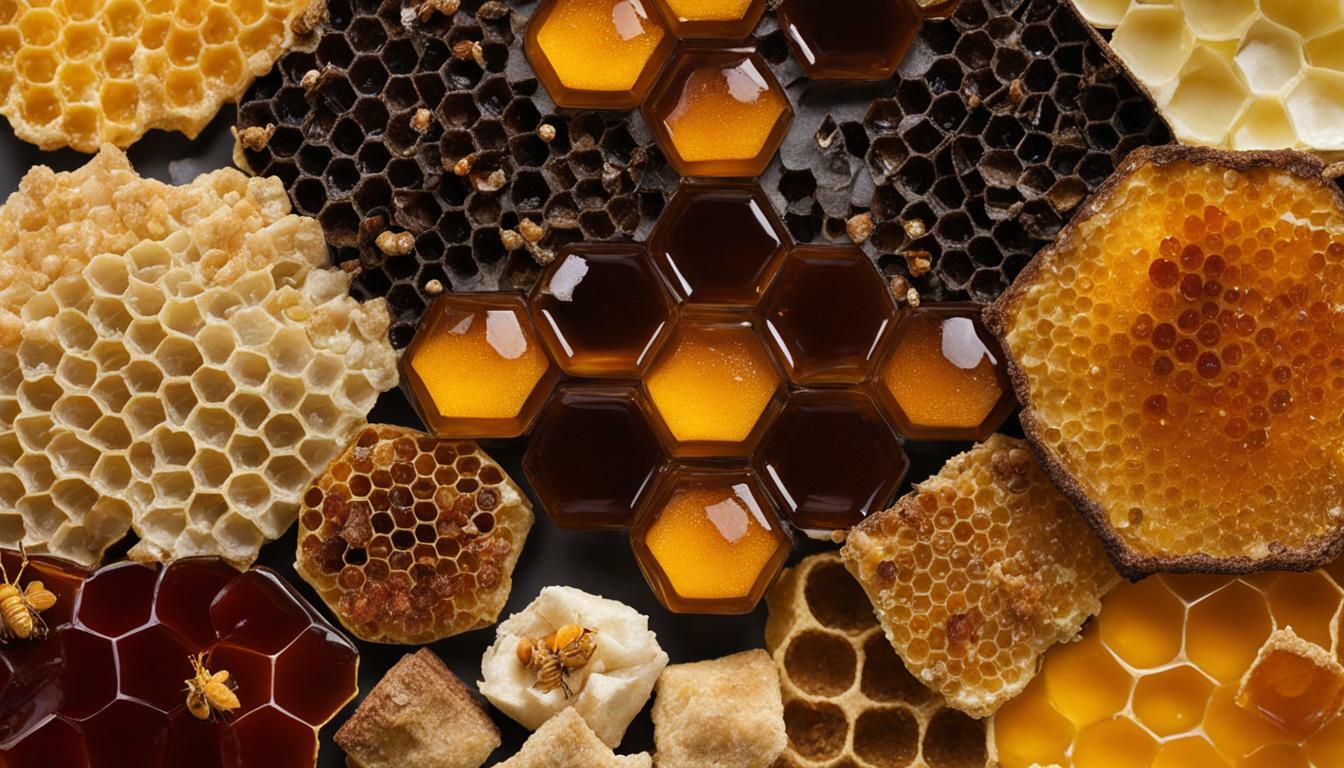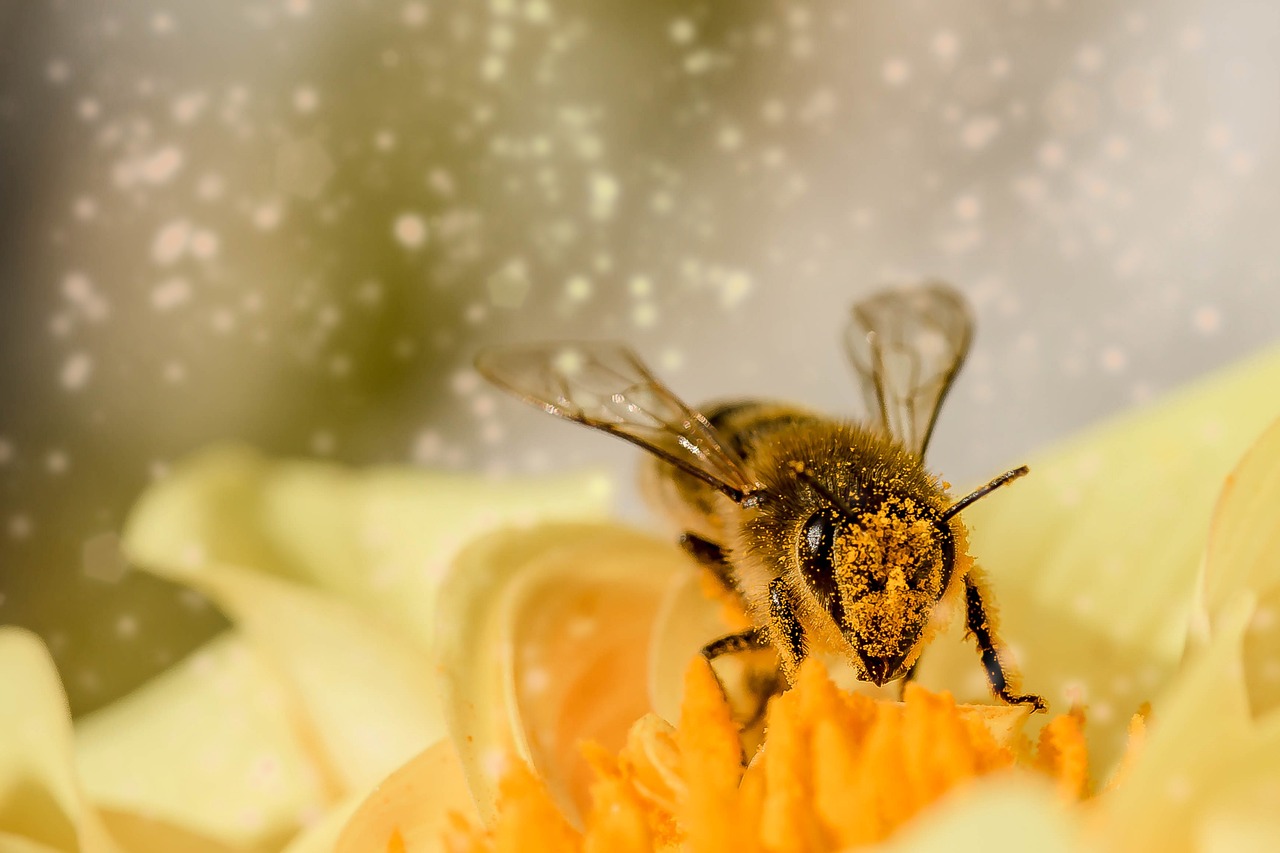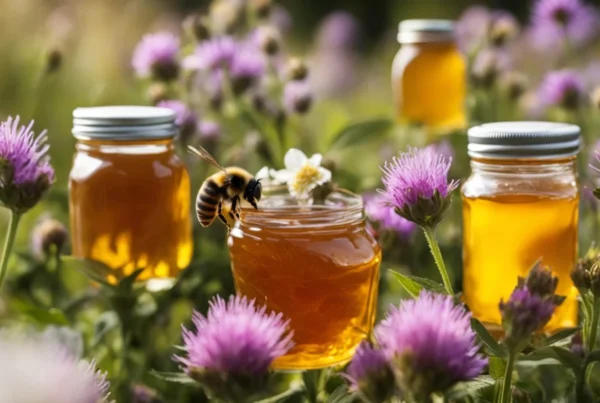
Honey is a natural sweetener that has been enjoyed by humans for centuries. It is not only delicious but also offers numerous health benefits. There are various types of honey available, each with its unique flavor and characteristics. In this article, we will explore the different types of honey, their benefits, and uses.
Key Takeaways
- Honey comes in various types, each with unique flavors and benefits
- Raw honey and monofloral honey are two popular types
- Honey has numerous health benefits, including antioxidant properties and soothing effects
- Honey is a versatile ingredient in cooking and also has beauty benefits
Exploring Raw Honey Types
Raw honey is a type of honey that has not undergone any processing or heating. This means that it retains all of its natural enzymes, antioxidants, and nutrients. Raw honey is often regarded as the best type of honey, as it provides a host of health benefits.
There are various types of raw honey available in the market. Some of the best types of raw honey include:
| Type of Raw Honey | Flavor Profile | Health Benefits |
|---|---|---|
| Manuka Honey | Rich, earthy, and slightly bitter | Antibacterial and anti-inflammatory properties, aids wound healing, boosts immunity |
| Buckwheat Honey | Dark and bold, with a molasses-like flavor | Antioxidant properties, soothes coughs and sore throats, helps alleviate allergies |
| Acacia Honey | Light and delicate, with a floral aroma | Rich in vitamins and minerals, aids digestion, promotes skin health |
Organic raw honey is another popular type of raw honey, as it is free from pesticides and additives. Organic honey types include clover honey, orange blossom honey, and lavender honey, among others. These raw honey types offer similar health benefits to their non-organic counterparts.
Exploring Raw Honey Types
“Raw honey is the best type of honey, providing a host of health benefits as it retains all of its natural enzymes, antioxidants, and nutrients.”
Incorporating raw honey into your diet is easy and delicious. You can use it as a natural sweetener in teas, coffee, and smoothies, or drizzle it over yogurt and fruit for a healthy dessert. Additionally, raw honey can be used as a natural remedy for various ailments, such as sore throats and allergies.
Overall, raw honey is a natural and nutritious sweetener that offers numerous health benefits. By incorporating different types of raw honey into your diet, you can enjoy their distinct flavors and reap their unique health benefits.
Unveiling Floral Honey Types
Floral honey types are as diverse as the flowers they are sourced from. Each type of floral honey has its own unique flavor profile, making them a delight for culinary enthusiasts and honey connoisseurs alike.
From lavender honey, which has a floral and slightly sweet taste, to orange blossom honey, which has a citrusy flavor, floral honey can add a complex and delicate flavor to a variety of dishes and drinks.
Other popular floral honey types include clover honey, which has a mild and sweet taste, and wildflower honey, which has a more robust flavor with hints of spice and earthiness.
But floral honey isn’t just versatile in the kitchen. Its unique flavors and origins also make it a great conversation starter and a delightful gift for friends and family.
So why not explore the diverse world of floral honey types and discover your new favorite variety?
The Magic of Monofloral Honey
Monofloral honey is a type of honey that is produced by bees that gather nectar from a single type of flower. The result is a honey that has a unique flavor and aroma, influenced by the dominant flowers in the area where the bees gather nectar. In this section, we will explore the different types of monofloral honey and what makes them so special.
Types of Monofloral Honey
Some of the most popular types of monofloral honey include:
| Honey Type | Flavor Profile |
|---|---|
| Manuka Honey | Intensely sweet with a slightly bitter aftertaste |
| Lavender Honey | Delicate and floral with a hint of menthol |
| Acacia Honey | Mild and sweet with a subtle vanilla flavor |
| Chestnut Honey | Dark and intense with a slightly bitter taste |
| Buckwheat Honey | Strong and robust with a molasses-like flavor |
Each of these honey types has its unique taste and aroma, making them perfect for different culinary applications.
Benefits of Monofloral Honey
Monofloral honey has been found to have several health benefits due to its high nutrient content and antibacterial properties. Some of the benefits include:
- Rich in antioxidants, which can help reduce inflammation and improve overall health.
- Effective in treating wounds and preventing infections, thanks to its antibacterial properties.
- Can help alleviate allergy symptoms, especially those caused by pollen from the flowers used to make the honey.
- Contains vitamins and minerals that promote good health and well-being.
In addition to its health benefits, monofloral honey is also widely used in the beauty industry to improve skin health and hair texture. It is a natural moisturizer that can help hydrate dry skin and hair, leaving them soft and supple.
As you can see, monofloral honey is a magical product that has many benefits for our health and beauty. Try incorporating different types of monofloral honey into your diet and beauty routines to experience their unique flavors and benefits.
Exploring Popular Honey Varieties
Honey is one of the oldest sweeteners used by humans, and it’s available in a wide range of varieties that differ in color, taste, and texture. Let’s explore some of the most popular types of honey used in the United States today:
| Honey Variety | Flavor Profile | Uses |
|---|---|---|
| Clover Honey | Mild and sweet | Great for baking, as a general sweetener, and in salad dressings |
| Manuka Honey | Strong and earthy | Believed to have medicinal properties and is often used as a natural remedy for sore throats and wounds |
| Acacia Honey | Delicate and light | Good for sweetening tea, drizzling over fruit, and in baking recipes that require a light touch |
Clover honey is the most popular honey variety in America, thanks to its mild taste and versatility in cooking and baking. Manuka honey, on the other hand, is a popular honey among health enthusiasts due to its supposed antibacterial properties. Acacia honey is a popular type of honey for those who prefer a light, delicate flavor.
Exotic and Unique Honey Varieties
Honey is not only a delicious natural sweetener but also a diverse ingredient with unique flavors and cultural significance. Below are some exotic and unique honey varieties from around the world:
| Honey Variety | Flavor Profile | Origin |
|---|---|---|
| Lavender honey | Delicate, floral, and slightly herbal | Provence, France |
| Chestnut honey | Strong, bold, and slightly bitter | Italy and Greece |
| Manuka honey | Earthy, rich, and medicinal | New Zealand |
| Buckwheat honey | Dark, molasses-like, and slightly malty | North America and Europe |
Lavender honey is produced in the Provence region of France, where lavender fields are abundant. This honey has a delicate floral flavor with a hint of herbal undertones. It pairs well with tea, yogurt, or as a glaze for baked goods.
Chestnut honey is harvested from bees that feed on the nectar of chestnut tree flowers in Italy and Greece. This honey has a strong, bold flavor with a slightly bitter aftertaste. It is often used in savory dishes, such as marinades for meats or as a spread on toasted bread.
Manuka honey is a unique honey variety native to New Zealand. It is produced by bees that feed on the nectar of the Manuka tree, which has medicinal properties. This earthy and rich honey is believed to have antibacterial and anti-inflammatory properties and is often used as a natural remedy for wound healing, sore throat, and digestive issues.
Buckwheat honey is a dark honey with a molasses-like flavor and slightly malty undertones. It is produced by bees that feed on the nectar of buckwheat flowers in North America and Europe. This honey is often used in baking, such as in bread or pancakes, and pairs well with strong cheeses or cured meats.
These exotic and unique honey varieties are just a few examples of the delightful diversity that nature offers. Each variety has its own distinct flavor profile, cultural significance, and potential health benefits. Incorporating different types of honey into your diet and culinary endeavors can add a delightful twist to your meals and provide a natural source of sweetness and nutrition.
The Health Benefits of Honey
Honey’s health benefits have been recognized for centuries. Besides being a natural sweetener, it is an excellent source of antioxidants, has antibacterial properties, and can offer relief to cough and sore throat.
Antioxidants
Honey is packed with antioxidants which assist in preventing cell damage in the body. Antioxidants neutralize free radicals that can cause oxidative stress, leading to chronic illnesses such as cancer and heart disease. The darker the honey, the higher its antioxidant content.
Antibacterial Properties
Studies suggest that honey has antibacterial properties, thanks to its high sugar content, acidity, and hydrogen peroxide. The antibacterial properties of honey can help to prevent infections, especially in wound healing.
Soothing Effect on Coughs and Sore Throats
Honey’s soothing properties can provide relief from coughs and sore throats. It coats the throat, helping to minimize irritation and suppress coughing. Honey with higher viscosity has better efficacy in relieving coughs and sore throats than those with lower viscosity.
Overall, consuming honey regularly can provide numerous health benefits, including reducing the risk of chronic illnesses and improving overall health.
Culinary Uses of Honey
Honey has been a culinary staple for centuries, enjoyed for its natural sweetness and unique flavor profiles. Apart from being a healthier alternative to processed sugars, honey can add depth and complexity to a wide range of dishes and beverages. Here are some ways you can incorporate honey into your cooking:
Baking
Honey can be used as a natural substitute for sugar in baked goods. Its unique flavor profile can enhance the taste of cakes, cookies, and bread. When baking with honey, remember to lower the oven temperature by 25 degrees Fahrenheit to prevent over-browning.
Cooking
Honey can be used as a glaze for meats and vegetables, adding a sweet and savory note to your dishes. It can also be used to balance the heat in spicy foods, creating a harmonious flavor profile.
Beverages
Honey can be used as a natural sweetener for tea, coffee, and smoothies. It can also be used to make honey syrups, which can be used in cocktails and mocktails.
When using honey in cooking, it’s important to note that it has a lower glycemic index than processed sugars, which means it can help regulate blood sugar levels. Additionally, honey has antimicrobial properties, making it a great natural remedy for coughs and sore throats.
Honey and Beauty
Honey has been used for centuries as a natural remedy for various skin and hair concerns. Due to its moisturizing and antibacterial properties, honey has gained popularity in the beauty industry. Here are some ways to incorporate honey into your beauty routine:
Skincare
Honey can be used as a natural face cleanser, as it gently removes dirt and impurities while moisturizing the skin. It is also known to have antioxidant properties, which can help prevent premature aging and promote a glowing complexion. To use, simply apply a small amount of honey onto damp skin, massage gently, and rinse with warm water.
In addition, honey can be used as a face mask to hydrate and soothe the skin. Mix equal parts honey and plain yogurt, apply the mixture to your face, and leave on for 15-20 minutes before rinsing off with water.
Hair Care
Honey is a great natural ingredient for hair care, as it can help to moisturize, nourish, and strengthen hair. It can be used as a hair mask by mixing honey with coconut oil and applying the mixture from roots to ends. Leave on for 30 minutes before shampooing as usual.
Additionally, honey can be added to your regular shampoo or conditioner to enhance its moisturizing properties. Simply mix a small amount of honey with your favorite shampoo or conditioner, and apply as usual.
Natural Remedy
Honey can also be used as a natural remedy for certain skin conditions, such as acne and eczema. Its antibacterial and anti-inflammatory properties can help to reduce redness and inflammation on the skin. Simply apply a small amount of honey onto the affected area, leave on for a few minutes, and rinse with water.
As you can see, honey has a wide range of uses beyond its sweet taste. Experiment with incorporating honey into your beauty routine and see the natural benefits for yourself.
Conclusion
From raw honey to monofloral honey, there is a wealth of different types of honey available, each with its unique flavor, texture, and health benefits. Floral honey types, such as lavender and chestnut honey, are particularly versatile and lend themselves well to various culinary applications.
Incorporating honey into a healthy diet has several health benefits, including antioxidant properties and potential antibacterial effects. Honey also adds a touch of natural sweetness to dishes, making it a perfect alternative to artificial sweeteners.
Moreover, honey has numerous beauty benefits and can be used as a natural remedy for various skin and hair conditions.
Overall, honey is a delightful natural sweetener and a versatile ingredient that can enhance both the taste and health value of your dishes. So next time you’re at the grocery store, be sure to explore different types of honey and discover the sweet treasures that nature has to offer.
FAQ
Q: What are the different types of honey?
A: There are various types of honey available, including raw honey, floral honey, monofloral honey, popular honey varieties, and exotic honey varieties.
Q: What is raw honey?
A: Raw honey is honey that has not been heated, processed, or pasteurized. It retains its natural enzymes and nutrients.
Q: What are the benefits of raw honey?
A: Raw honey is known for its antibacterial properties, antioxidant content, and potential soothing effects on coughs and sore throats.
Q: What are floral honey types?
A: Floral honey types are made from the nectar of various flowers, resulting in distinct flavors and aromas.
Q: What is monofloral honey?
A: Monofloral honey is produced by bees from the nectar of a single flower source, resulting in honey with a specific flavor profile.
Q: What are some popular honey varieties?
A: Some popular honey varieties include clover honey, manuka honey, and acacia honey, each with its own unique characteristics.
Q: Are there exotic honey varieties?
A: Yes, there are exotic honey varieties such as lavender honey, chestnut honey, and buckwheat honey, each with its own distinct flavors.
Q: What are the health benefits of honey?
A: Honey has antioxidant properties, can soothe coughs and sore throats, and may possess antibacterial properties.
Q: How can honey be used in cooking?
A: Honey can be used in baking, cooking, and as a natural sweetener in various dishes and beverages.
Q: Are there beauty benefits of honey?
A: Yes, honey can be used in skincare, hair care, and as a natural remedy for certain skin conditions.




